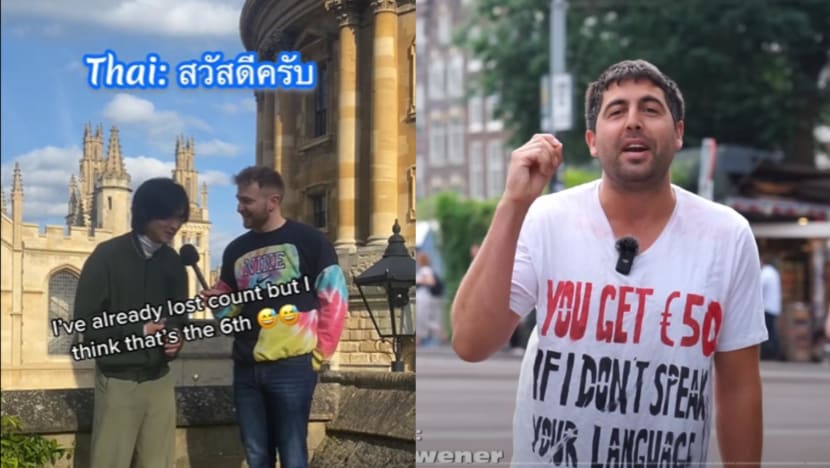Commentary: Singaporean who speaks 11 languages should inspire even those who struggle with our mother tongue
If we struggle with our mother tongue despite years in school, do we lack innate talent for languages? Most of us won’t end up speaking 11 languages like Oxford student Jonas Fine Tan, but his story should inspire us to try, says NUS Centre for Language Studies’ Daniel Chan.

Composite of (left) Singaporean Oxford University undergraduate Jonas Fine Tan (Screengrab: TikTok/oliversoxford) and Dutch polyglot Wouter Corduwener in a tshirt that reads "You get €50 (US$55) if I don't speak your language" (Screengrab: Youtube/Wouter Corduwener)
SINGAPORE: Jonas Fine Tan, a 23-year-old Singaporean studying at Oxford University, recently went viral for speaking 11 languages in a TikTok video. Some may also remember a 14-year-old Cambodian street hawker, Thuch Salik, whose remarkable showcase of 16 languages in a 2018 viral video earned him a scholarship to study in Beijing.
Social media have also been abuzz with discussions about learning new languages, perhaps driven by the emergence of popular polyglot influencers.
One American YouTuber, who goes by Xiaomanyc, produces videos about surprising native speakers in everyday language, such as ordering food in fluent Mandarin. Then there is a Dutch hyperpolyglot, Wouter Corduwener, whose surreal challenge is to offer cash payments to anyone speaking a language unfamiliar to him.
Does this fascination towards polyglots suggest we view plurilingualism as a rare talent, seen only in the gifted? Or can everyone learn to speak a new language - if they knew how?
WHAT QUALIFIES AS SPEAKING A LANGUAGE?
If you are reading this in Singapore, the odds are that you are literate in at least two languages, according to the 2020 Census of Population. This is presumably a result of our language planning policies, which prioritise bilingualism.
That said, some of us probably aren’t quite confident in calling ourselves bilingual: Years of mother tongue classes in school have not necessarily translated into lasting language proficiency.
Self-proclaimed polyglots would probably meet with some scepticism too: Does knowing a few phrases really qualify as speaking a language?
Ultimately, language learners target different proficiency levels based on their goals. Someone travelling for a short trip might only aim for the basic level, while someone moving abroad might aspire to achieve near-native fluency.
But there is no need to have full mastery of a language to qualify as a speaker.
Although Jonas Fine Tan only showed off some simple greetings in the viral TikTok video, he revealed in an interview with local media that he was able to hold complex conversations in Mandarin, Spanish, Portuguese and Thai and simple conversations in Tamil, Vietnamese and Italian, and that he could speak Hokkien, Tagalog and Malay at a functional level.
Some people may falsely think they need to first learn the written language before attempting to speak it, but speaking and writing are two separate skills that can be acquired independently.
Importantly, the spoken and written forms of virtually all modern languages differ. For example, conversational Malay often contains colloquial expressions, contracted forms and a syntax that is more flexible than formal written Malay. A learner relying mainly on written Malay may sound stilted and awkward in everyday communication.
Nearly half of the world’s living languages - including Hokkien and other Chinese dialects - do not have a standardised writing system. This has never prevented anyone from learning to speak those languages.
FOR THOSE WHO STRUGGLE WITH MOTHER TONGUE
But if we struggle with our heritage language despite formal classes and some level of daily exposure, might this suggest we simply lack innate linguistic talent and shouldn’t try picking up another language?
Since learning language is a skill, it can be cultivated over time - by arguably anyone - if given the right amount of time, motivation, learning conditions and approach, and exposure to the language.
As a French language teacher, I have come across many who doubt they can handle the challenges of learning additional languages when they still feel inadequate in their own mother tongue. This preconceived idea might be due to the misunderstanding that language skills are developed in a linear fashion, with each one setting the foundation for the next.
There is no scientific basis, however, for why languages should be learned sequentially. Our brains can segregate different languages and access them efficiently as needed, so humans are naturally equipped to manage multiple languages concurrently.

There are countless examples of children growing up multilingual, such as with the One Parent One Language method where each parent speaks exclusively in one language to the child. By associating one language with a particular person or function, our brain can be trained to know exactly when and where each language is to be used.
EXPOSURE TO THE SPOKEN LANGUAGE IS KEY
While many popular polyglot influencers seem to be self-taught, we cannot expect to achieve fluency by simply relying on lessons, books and apps.
Though these are useful tools to help explain grammar, vocabulary and other theoretical aspects, we need to be immersed in the comprehensible spoken language as much as possible to foster speaking proficiency, according to linguistic expert Stephen Krashen.
Opportunities for this include conversing with native speakers, watching movies or shows in the target language, and simply letting the spoken language play in the background. It increases our chances of encountering frequently used words and phrases, and the better we can absorb and replicate the natural rhythm, intonation and informal expressions.
Jonas Fine Tan, for instance, learnt Thai not just from textbooks but by interacting with native speakers, hanging out at a Thai restaurant near his mother’s workplace over the years. Such real-world practice can help not only to improve speaking proficiency but also to understand the nuances, colloquialisms and cultural contexts over a detached set of grammar rules and vocabulary.
PASSION, PRACTICE, PERSEVERANCE
Passion may motivate us to seek out a new language. Practice turns the acquired knowledge into an active skill. But it is perseverance that keeps us going in the face of challenges and puts time to work in our favour.
The theory of aggregate marginal gains may have been made famous by a British cycling coach, but the concept of making a 1 per cent daily improvement that would mathematically lead to a 38-fold improvement after a year can apply to any skill. Language learning is a marathon, not a sprint.
The linguistic prowess of Jonas Fine Tan at a young age is a reflection of his curiosity, dedication and a fearless approach towards mistakes - traits that all language learners should aspire to have. He should inspire us to start our own language learning journey - be it to delve into a foreign culture, foster intercommunity understanding or seize a business opportunity - even if most of us will not end up learning as many as 11 languages.
Dr Daniel Chan is Assistant Dean (Undergraduate Studies) at the Faculty of Arts and Social Sciences, National University of Singapore.


















